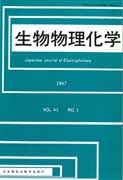All issues

Successor
Volume 41 (1997)
- Issue 6 Pages 279-
- Issue 5 Pages 226-
- Issue 4 Pages 169-
- Issue 3 Pages 95-
- Issue 2 Pages 43-
- Issue 1 Pages 1-
Volume 41, Issue 3
Displaying 1-10 of 10 articles from this issue
- |<
- <
- 1
- >
- >|
-
M. Zouhair Atassi, Minako Oshima1997 Volume 41 Issue 3 Pages 95-110
Published: June 15, 1997
Released on J-STAGE: March 31, 2009
JOURNAL FREE ACCESSStudies from this laboratory have mapped and synthesized the functional (i.e. acetylcholine and α-neurotoxin binding) sites as well as the sites of immune and autoimmune T- and B-cell recognition of Torpedo californica (t) and human acetylcholine receptor (AChR). Antibodies against tAChR and mouse (m) AChR α-chain peptides have been used to map the surface accessibility of the α-chain extracellular domain in soluble (i.e. free) and in membrane-bound tAChR as well as in mAChR on a live muscle cell line in culture. Myasthenia gravis is a disease caused by autoantibodies against AChR. Yet, we have found on the molecule a pathogenic T-cell epitope which does not bind anti-AChR antibodies. It has been shown, for the first time, that T cells which recognize this region of the receptor to which no autoantibodies are detectable are pathogenic because they provide help to, and activate, B cells that make antibodies against a region of the molecule known to be involved in the binding of the effector moleucule. We have also performed studies, which have been quite successful, on the manipulation of the autoimmune antibody and T cell responses by synthetic peptides. These studies should open up important avenues for the use of synthetic peptides in the manipulation and control of unwanted immune responses.View full abstractDownload PDF (2087K) -
Shoji Harada1997 Volume 41 Issue 3 Pages 111-116
Published: June 15, 1997
Released on J-STAGE: March 31, 2009
JOURNAL FREE ACCESSDownload PDF (4100K) -
Kiyotaka Fujita, Ikunosuke Sakurabayashi1997 Volume 41 Issue 3 Pages 117-120
Published: June 15, 1997
Released on J-STAGE: March 31, 2009
JOURNAL FREE ACCESSDownload PDF (2866K) -
Kiyoko Shiba1997 Volume 41 Issue 3 Pages 121-125
Published: June 15, 1997
Released on J-STAGE: March 31, 2009
JOURNAL FREE ACCESSDownload PDF (649K) -
Shigemi Hosogaya, Shoji Kume, Kiyotaka Fujita, Ikunosuke Sakurabayashi1997 Volume 41 Issue 3 Pages 127-131
Published: June 15, 1997
Released on J-STAGE: March 31, 2009
JOURNAL FREE ACCESSElectrophoretic determination of serum protein fractions with cellulose acetate membranes is a widely used clinical test, and it is largely determined by fully automated analyzers. However, quality control and standardization of protein fractions has not been discussed until now, because the numerical character of protein fraction ratios is distinct from that of general quantitative data. We analyzed between- and within-laboratory variations of control survey data, and found the presence of significant errors of between-laboratory and between-day variations in fraction ratios. They are attributed to the types of cellulose acetate membranes and automated analyzers. We applied a x-Rs-R control chart method for the determination of protein fractions, the values of which have inherent analytical variations by between- and within-day errors. This quality control method is suitable for assuring reliability in the electrophoretic determination of serum protein fractions.View full abstractDownload PDF (673K) -
Shuji Matsuo1997 Volume 41 Issue 3 Pages 133-137
Published: June 15, 1997
Released on J-STAGE: March 31, 2009
JOURNAL FREE ACCESSReference interval is a term to replace normal range. It is recommended that reference intervals with a clear description of subjects and procedure be commonly used. In this study, reference intervals were established for common use, since normal ranges differ among many institutions and cellulose acetate membranes without electric penetration are commonly used. Reference intervals were established based on data from adults undergoing physical examination at two institutions, according to the method described by the National Committee for Clinical Laboratory Standards (NCCLS). As a consequence, it was shown that age, sex and the presence or absence of habitual smoking, alcohol consumption and obesity contributed to some degree of differences. However, these differences did not influence clinical decision making. Since it was impractical in medical practice to express reference intervals on various physiological conditions or life habits, one reference interval was established for each protein fraction. If accuracy is sufficiently controlled and good results are obtained in a control survey, these reference intervals can be made available for wide spread use. Author hopes that this study will promote the common use of reference intervals for serum protein fractions.View full abstractDownload PDF (650K) -
Harutaka Mukoyama1997 Volume 41 Issue 3 Pages 139-144
Published: June 15, 1997
Released on J-STAGE: March 31, 2009
JOURNAL FREE ACCESSDownload PDF (776K) -
Akio Koizumi1997 Volume 41 Issue 3 Pages 145-148
Published: June 15, 1997
Released on J-STAGE: March 31, 2009
JOURNAL FREE ACCESSDiscoveries of two mouse models of obesity, ob/ob and db/db mice, gave the first momentum to conduct molecular approaches for obesity and lead to discoveries of leptin and its receptors. Leptin, its receptors, and other related signal transducers form a network to maintain the amounts of fat in the body at the apriori-determined “Set point.” In this network, leptin conveys signals as a messenger from adipose tissues to brain to balance energy intake and expenditure: the former is regulated by appetite and the later controlled by heat production. The discovery of leptin gave hopes of many people because it may be an anti-obesity drug, although only a minor proportion of obese pepole is expected to respond it. The dream of such a marvelous drug for obesity was brough closer to reality recently.View full abstractDownload PDF (572K) -
Ikuo Nakamura1997 Volume 41 Issue 3 Pages 149-154
Published: June 15, 1997
Released on J-STAGE: March 31, 2009
JOURNAL FREE ACCESSDownload PDF (2374K) -
Haruo Yamanouchi1997 Volume 41 Issue 3 Pages 155-159
Published: June 15, 1997
Released on J-STAGE: March 31, 2009
JOURNAL FREE ACCESSDownload PDF (602K)
- |<
- <
- 1
- >
- >|